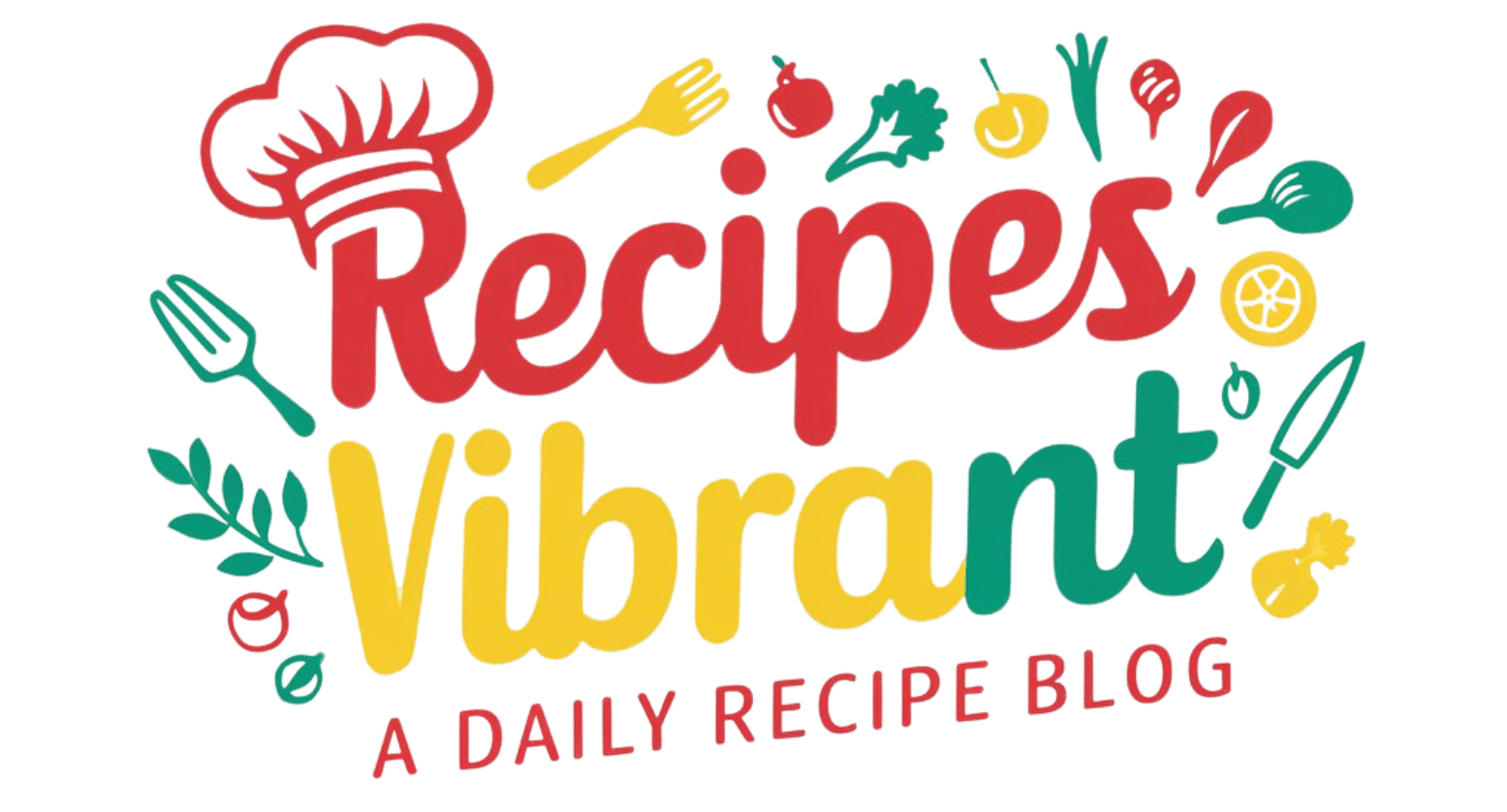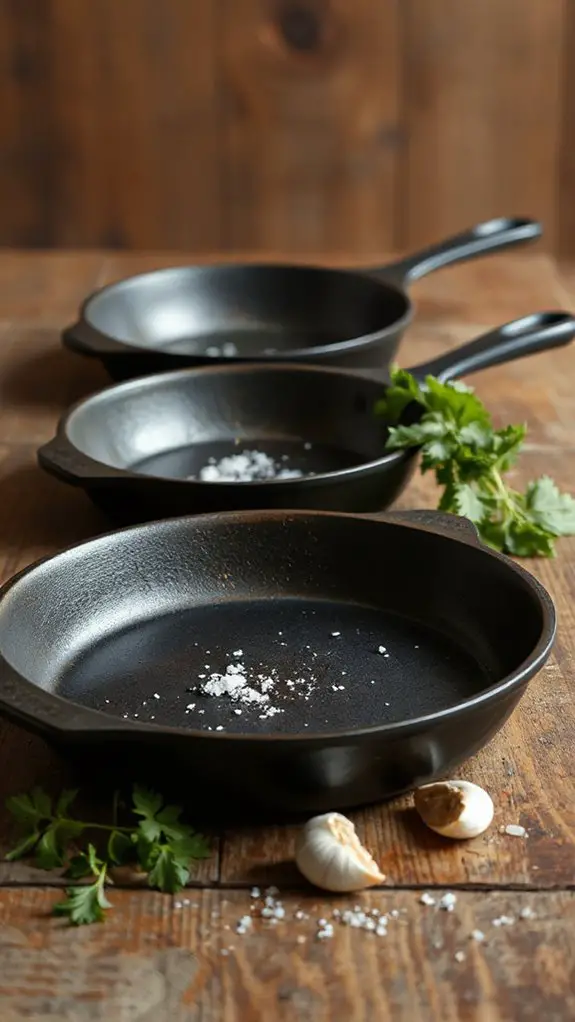I recently tried the Lodge 12-inch cast iron skillet for searing steaks, and the even heat distribution blew me away—no more cold spots ruining my dinner. But with so many options out there, how do you pick the right one? I’ve narrowed it down to three standout skillets that balance durability, versatility, and ease of use, each with its own strengths. Let’s see which one might become your kitchen’s MVP.
Lodge 12 Inch Cast Iron Skillet with Silicone Handle Holder
The Lodge 12 Inch Cast Iron Skillet with Silicone Handle Holder is perfect for home cooks who want a versatile, long-lasting pan that works on any heat source. Its pre-seasoned surface guarantees a nonstick finish, making it ideal for searing, frying, or baking. The silicone handle holder keeps hands safe, while the assist handle improves control. Weighing 8 pounds, it’s sturdy but manageable, offering even heat distribution for consistent results. Crafted in the USA by Lodge, it’s built to last generations. With care, this skillet becomes more nonstick over time, making it a must-have for anyone who loves cooking.
Best For: Home cooks seeking a versatile, durable skillet for consistent cooking on any heat source.
Pros:
- Pre-seasoned surface ensures a nonstick finish.
- Silicone handle holder provides safe, comfortable grip.
- Superior heat distribution and retention for even cooking.
Cons:
- Heavy at 8 pounds, which may be cumbersome for some users.
- Requires hand washing; not dishwasher safe.
- Additional seasoning may be needed for optimal nonstick performance.
Lodge 10.25 Inch Cast Iron Skillet – Pre-Seasoned Frying Pan
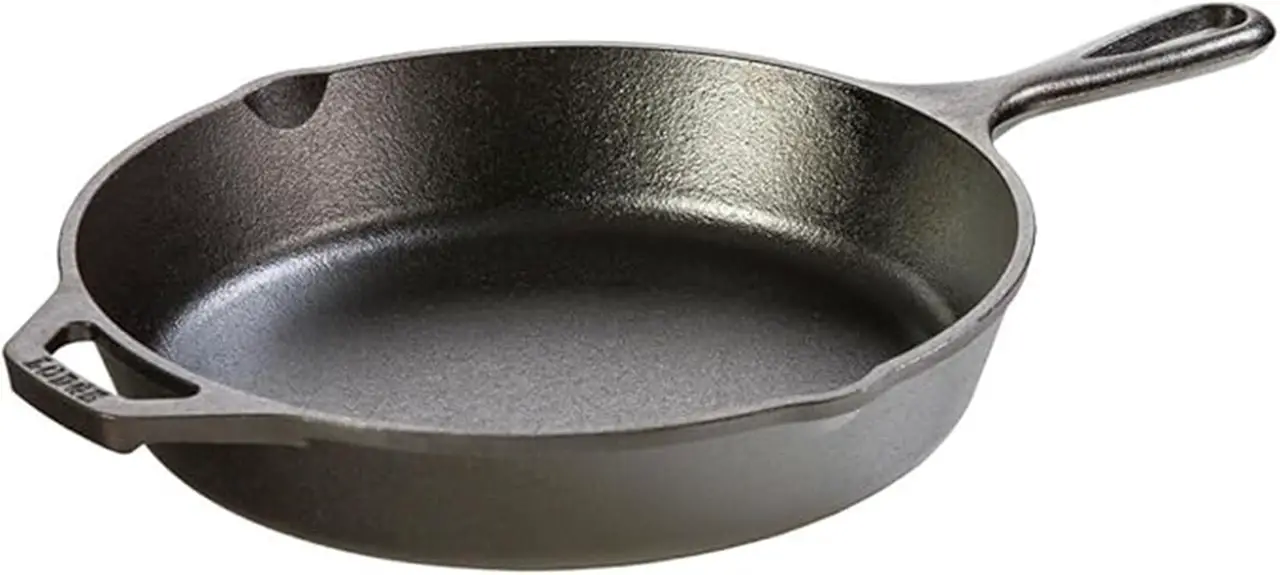
For home cooks who value versatility and durability in their kitchen tools, the Lodge 10.25 Inch Cast Iron Skillet – Pre-Seasoned Frying Pan is a standout choice. Made in the USA by a family-owned company since 1896, this skillet’s pre-seasoned surface means it’s ready to use right away for searing, frying, baking, and more. Its even heat distribution guarantees your meals cook perfectly, whether on the stovetop, grill, or campfire. Hand wash only, it’s PFAS-free and non-toxic, making it a safe option for everyday cooking. With proper care, including regular seasoning, this skillet becomes a reliable kitchen companion for years.
Best For: Home cooks seeking a versatile, durable, and non-toxic skillet for searing, frying, baking, and grilling.
Pros:
- Pre-seasoned and ready to use right away, saving time and effort.
- Excellent heat distribution and retention for even cooking on various heat sources.
- PFAS-free and non-toxic, making it a safe choice for health-conscious users.
Cons:
- Requires hand washing and regular seasoning, which may be inconvenient for some.
- Heavy weight (5.06 lbs) can make handling difficult for some users.
- Not dishwasher safe, limiting cleaning options.
Utopia Kitchen Cast Iron Frying Pan 12 Inch, Pre Seasoned Skillet
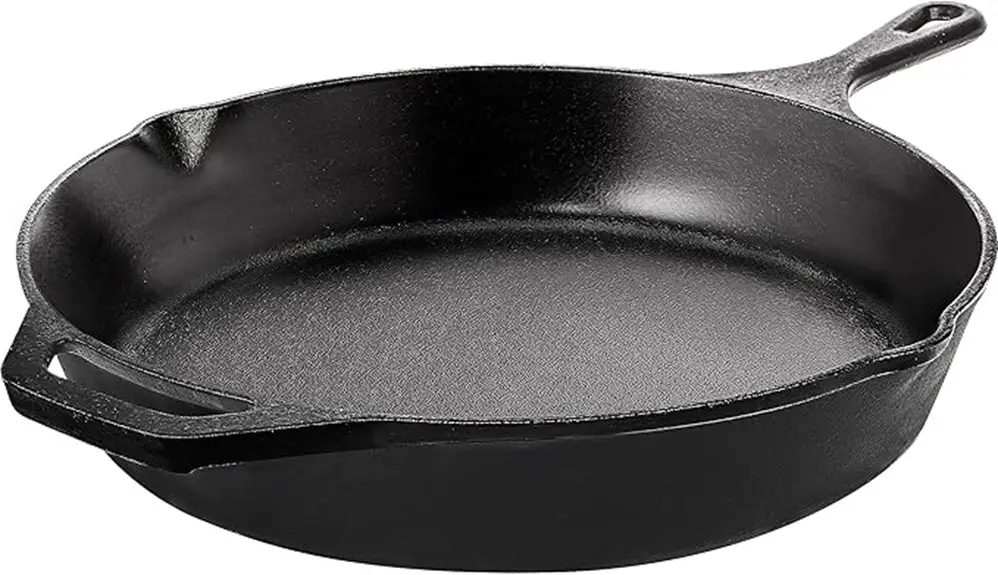
Looking for a versatile skillet that can handle everything from searing steaks to baking cornbread? The Utopia Kitchen Cast Iron Frying Pan delivers with its 12-inch size, pre-seasoned surface, and even heat distribution. It’s perfect for stovetops, ovens, or campfires, making it a go-to for any cooking adventure. The ergonomic handles stay cool enough to grip, though some wish they were longer. Users love its durability and affordability, but remember—it’s hand wash only to keep the seasoning intact. A little extra oil after cleaning keeps it non-stick and rust-free. With over 26,000 glowing reviews, it’s a crowd-pleaser for good reason.
Best For: Home cooks and outdoor enthusiasts seeking a durable, versatile cast iron skillet for various cooking methods.
Pros:
- Superior heat retention for even cooking
- Pre-seasoned for enhanced non-stick performance
- Compatible with stovetops, ovens, grills, and campfires
Cons:
- Handles could be longer
- Hand wash only; not dishwasher-safe
- Requires regular seasoning maintenance
Factors to Consider When Choosing a Cast Iron Skillet
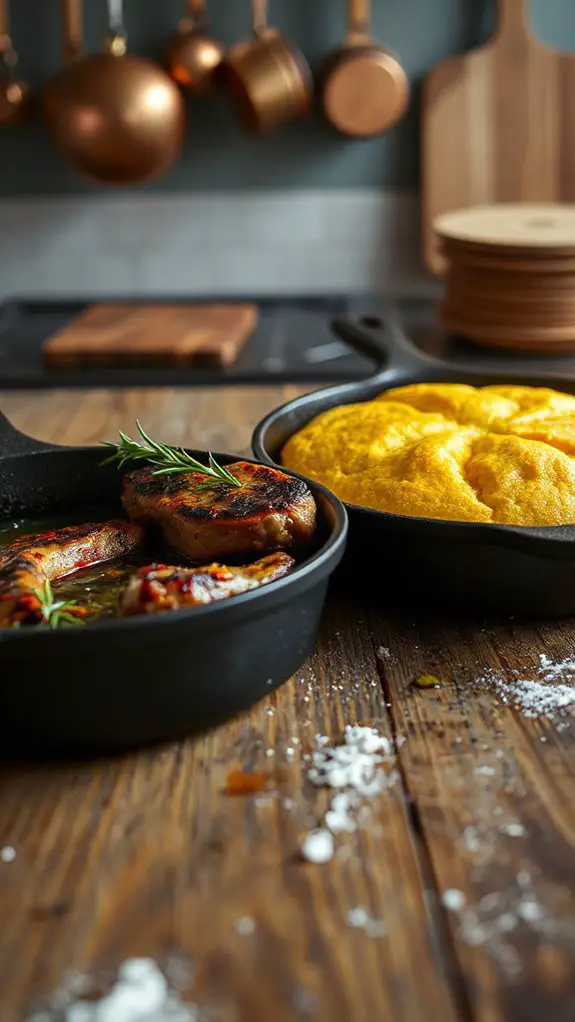
When picking a cast iron skillet, I make sure to think about size and capacity first, so it fits my cooking needs just right. I also pay attention to heat distribution and material quality, ensuring it cooks evenly and lasts a long time. Finally, I check the handles for comfort and grip, and consider how easy it’ll be to maintain after use.
Size and Capacity
I’ve found that choosing the right size and capacity for a cast iron skillet can make or break my cooking experience, especially when I’m juggling different meal plans. For everyday meals, I prefer a 10-inch skillet if I’m cooking for two or three people—it’s just the right size without being too bulky. When I’m feeding my whole family, though, I grab my 12-inch skillet because it gives me enough room to sear multiple chicken breasts or sauté a big batch of veggies at once. I also pay attention to the skillet’s depth, since I love making stews or casseroles and need something deeper to prevent spills. Smaller skillets heat up faster and are easier to handle, but for bigger meals, I rely on larger ones for their consistent performance and generous capacity.
Heat Distribution
After figuring out the perfect size for my cast iron skillet, I turned my attention to how it handles heat. The dense material makes these skillets champions of heat distribution, ensuring my food cooks evenly without annoying hot spots. I’ve noticed preheating is key—when I take the time to warm it up properly, the skillet performs like a dream, whether I’m searing a steak or frying eggs. The thickness of the cast iron keeps the heat consistent, so nothing burns or undercooks. Plus, once it’s hot, it stays hot, which is perfect for keeping dishes warm at the table. Over time, I’ve found that regular seasoning improves its heat distribution, making it even better with each use. It’s like the skillet and I are growing together in the kitchen!
Material Quality
Choosing the right cast iron skillet starts with understanding the material quality, because it’s the foundation of how well the skillet performs. I always look for skillets made from pure cast iron, as they’re incredibly durable and distribute heat evenly. Synthetic coatings like PFOA or PTFE? No thanks—I prefer my cookware free from harmful chemicals. Proper seasoning with natural oils not only boosts nonstick properties but also keeps rust at bay. A heavy, thick skillet is my go-to since it holds heat better and cooks food more consistently. I’ve found that skillets with consistent material density prevent hot spots, so everything browns evenly. It’s these details that make a difference, and trust me, once you experience high-quality cast iron, you’ll never look back.
Handles and Grip
Since a great handle makes all the difference when lifting a hot skillet, it’s worth paying attention to grip and design. I always look for ergonomic handles that feel secure, even when I’m wearing oven mitts. It’s a small detail, but it keeps me from dropping anything—trust me, hot skillets aren’t fun to chase! Assist handles are a bonus for larger skillets, making them easier to lift and move around. I also love silicone handle holders—they’re a lifesaver when grabbing a hot handle straight from the oven. Length matters too; longer handles give better leverage but take up more space, so I think about my storage before committing. Finally, I make sure the handle is sturdy and securely attached—nothing’s worse than a wobbly skillet mid-cook!
Maintenance Requirements
Although cast iron skillets are known for their durability, they do require a bit of care to keep them in top shape. I always season mine with a light layer of cooking oil after each use—it keeps the skillet nonstick and rust-free. Hand washing with warm water and mild soap works best; dishwashers can strip the seasoning and cause damage. I make sure to dry it thoroughly right after washing to avoid moisture buildup, which can lead to rust over time. If food starts sticking or the surface looks dull, I re-season it to restore its performance. I’ve learned to avoid soaking it in water or using abrasive scrubbers since those can weaken the seasoning and expose the iron to corrosion. A little maintenance goes a long way!
Versatility in Cooking
Cast iron skillets are like the multitaskers of the kitchen, handling everything from searing a steak to baking a cornbread with ease. I love how they shift from stovetop to oven, making them perfect for recipes that need both, like a cheesy casserole or a gooey skillet cookie. Their even heat distribution guarantees my food cooks consistently, whether I’m slow-cooking a stew or getting a perfect sear on a pork chop. Plus, they work on almost any heat source—gas, electric, induction, even a campfire, which is great for outdoor adventures. Over time, proper seasoning turns them into a nearly nonstick dream, so I can flip eggs with confidence or crisp up bacon without a hitch. Versatility like this makes them a must-have in my cooking arsenal.
Frequently Asked Questions
Can Cast Iron Skillets Be Used on Induction Cooktops?
I’m glad you asked—cast iron skillets work perfectly on induction cooktops because they’re magnetic, which is essential for induction heating. I use mine regularly without issues, and it heats evenly and efficiently every time.
How to Restore a Rusted Cast Iron Skillet?
I scrub a rusted cast iron skillet with steel wool or a brush to remove loose rust. Then, I wash it with warm, soapy water, dry it thoroughly, and apply a thin layer of oil to re-season it.
Are Cast Iron Skillets Dishwasher Safe?
I wouldn’t put my cast iron skillet in the dishwasher. The harsh detergents and high heat can strip its seasoning, leading to rust and damage. Instead, I hand wash it with warm water and a gentle scrub.
Can You Cook Acidic Foods in a Cast Iron Skillet?
I’ve always walked on eggshells when cooking acidic foods in a cast iron skillet. It can leach iron and affect flavors, but I’ve found it’s manageable if I keep cooking times short and the skillet well-seasoned.
How Often Should I Season My Cast Iron Skillet?
I season my cast iron skillet every few months or whenever it looks dull or feels sticky. After cooking acidic foods or scrubbing heavily, I check it more often and re-season if needed to maintain its non-stick surface.
Conclusion
After testing these skillets, I’m convinced they’re the real deal. Lodge’s 12-inch pan kept my hands safe and cooked evenly, while their 10.25-inch version made stovetop-to-oven cooking a breeze. Utopia Kitchen’s 12-inch skillet proved you don’t need to break the bank for quality. Each one lasted through my weekly meal prep with just a little care. Trust me, these skillets are worth the investment for any home cook.
